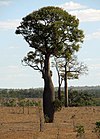Brachychiton rupestris in the family Malvaceae, commonly known as the Queensland bottle tree, is native to Queensland, Australia. Discovered and described by Sir Thomas Mitchell and John Lindley in 1848, it gained its name from its bulbous trunk, which can be up to 3.5 metres (11 ft) diameter at breast height. Reaching 10–25 metres (33–82 ft) high, the tree is deciduous, losing its leaves between September and December. Cream flowers appear from September to November, followed by woody boat-shaped follicles that ripen from November to May. It is an emergent tree in the endangered central semi-evergreen vine thickets of the Brigalow Belt. Remnant trees are often left by farmers on cleared land to provide shade and fodder. As a drought-deciduous succulent tree, the bottle tree adapts readily to cultivation and is tolerant of a range of soils and temperatures. It is found planted in streets, parks, and gardens and on farms. An avenue in Roma, Queensland, was planted between 1918 and 1920, each tree representing one of 93 local men killed in World War I. The species is also cultivated as an indoor plant and a bonsai subject. (Full article...)
- Recently featured:
from Wikipedia featured articles feed http://ift.tt/1TWmGeW







0 commentaires:
Enregistrer un commentaire